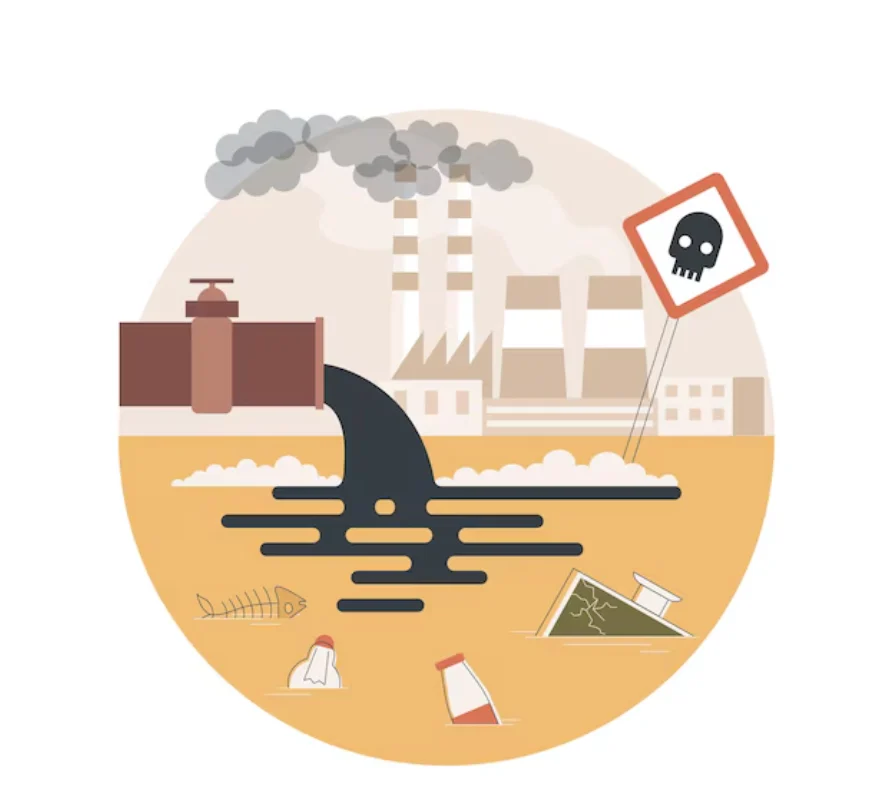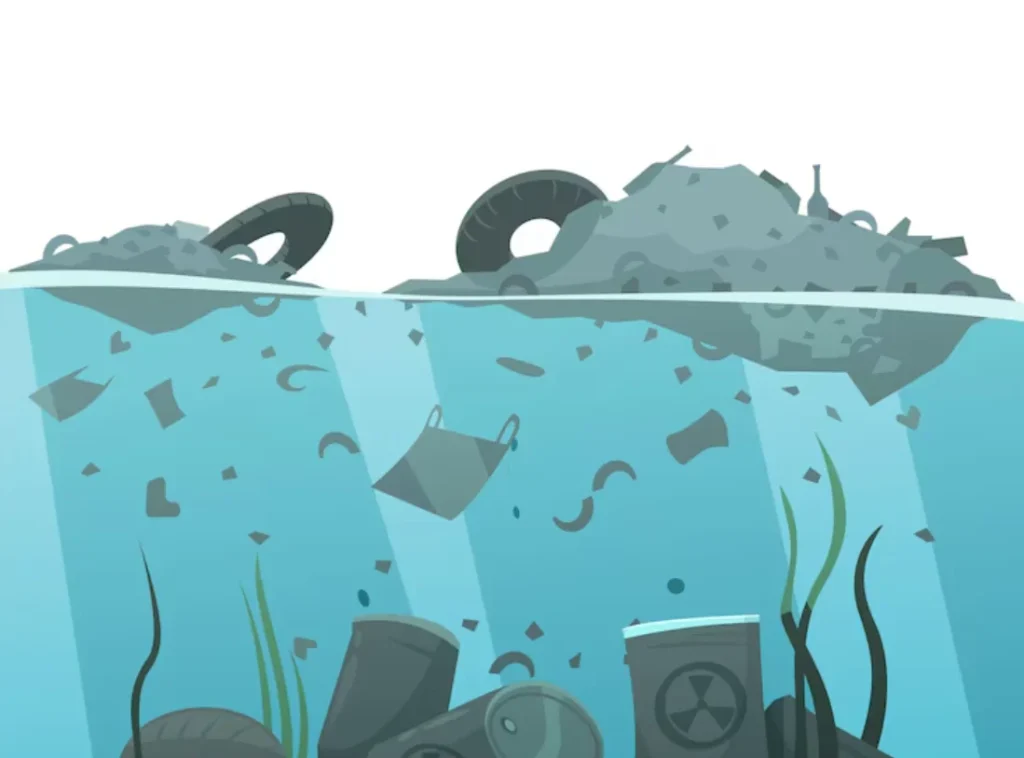INTRODUCTION:

Today on the blog, we talk about one of Australia’s most important and urgent environmental concerns of water pollution. Water is an essential commodity for all life on Earth, and pollution of it affects not only human health but also the fragile habitats that support a great portion of Australia’s fauna. From the Great Barrier Reef to inland rivers, Australian waterways have never been so contaminated. This problem isn’t just an environmental problem; it’s a public health concern, an economic burden, and a threat to biodiversity.
In this blog, we’ll go into detail about how water is being polluted in Australia and what the consequences of water pollution can be, in addition to outlining ways to prevent it. At the end of this post, you will have a greater appreciation of why water contamination is a problem in Australia and how water pollution can be addressed.
What is Water Pollution?
Water pollution is the contamination of water bodies (like rivers, oceans, lakes, aquifers, and groundwater), usually caused by human activities. These contaminants may be physical, chemical, or biological, and are frequently responsible for water quality impairment. Water pollution is emerging as a major environmental problem in Australia due to increased urbanization, industrial activities, agricultural practices, and climate change. Its special water world is particularly sensitive to polluted sources of water, given the abundance of aquatic life and natural resources.
Understanding Water Pollution in Australia
In a country with wide-ranging landscapes like Australia, water pollution issues are unique. While water pollution impacts various areas differently, from urban to rural farming, it affects all areas of the country. Australia’s dependence on its freshwater resources for drinking water, agriculture, and industry means it is vital to manage sources of pollution in its waterways effectively. The nation also boasts many sensitive, rare, and precious ecosystems like the Great Barrier Reef that are incredibly vulnerable to water pollution.
Australia has immense water resources, such as large rivers, like the Murray-Darling, that run across southeastern Australia. These rivers supply millions of people with water, but they are also susceptible to pollution from farm runoff, mining, and urban waste. Additionally, coastal waters and life are threatened by plastic debris, industrial waste, and oil spills.
Main Causes of Water Pollution in Australia
1. Agricultural Runoff and Chemical Contamination
- Agriculture is one of the leading causes of water pollution in Australia. Nutrient runoff from the use of fertilizers, pesticides, and herbicides in farming finds its way into local water supplies. This runoff carries too many nutrients to the water, including nitrogen and phosphorus. These are the three main nutrients causing eutrophication in the eutrophicated bodies of water. It occurs when the increased nutrient load favors the development of toxin-producing algae that draw down oxygen from the water, driving underwater species away.
- In areas such as the Murray-Darling Basin, intensive farming practices have been associated with water pollution. They are rich in synthetic chemicals and routinely escape from crop, animal, and aquaculture farming operations, and in so doing, they contaminate water bodies with negative consequences for the health of the water and related flora and fauna.
2. Industrial Waste and Pollutants
- Industrial processes throughout the country have a clear effect on water quality. Water pollution is generated by mining, oil and gas extraction, and chemical manufacturing. Decisions by humans are also typically the root cause. For example, leaves behind detrimental substances like heavy metals and toxic chemicals in water systems. In remote regions like the outback, mining projects have the potential to usher in large sediment, metal, and toxin inputs into nearby river and groundwater systems.
- Take the example of coal mines in Queensland and New South Wales polluting river systems with heavy metals and poisonous chemicals. Mining companies must adhere to tight environmental rules, but enforcement is often lax, and pollution from unauthorized discharges is common.
3. Urban Wastewater and Stormwater Runoff
- Australian cities, including Sydney, Melbourne, and Brisbane, pollute water through effluent from wastewater treatment plants and stormwater. Urban stormwater can be laden with oil, trash, heavy metals, and other contaminants from roads, parking lots, and industrial areas. Stormwater then washes off these surfaces and into rivers, lakes, and seas, taking with it a litany of harmful pollutants.
- Furthermore, on-site sewage treatment plants for cities are often insufficient for the peak sewage, and sewer overflows occur, leading to untreated or partly treated human waste dumping directly into the surrounding water. Such discharges frequently include pathogens, chemicals, and other pollutants that can endanger both drinking water and aquatic life.
4. Plastic Pollution and Marine Waste
- Australia’s coastlines are decimated by plastic pollution. The country, with more than 25,000 kilometers of coastline, has large waste management problems, particularly with plastic. Household, industrial, and tourism-related plastic waste often makes its way to the ocean, where it breaks into little pieces called microplastics. The small particles are eaten by sea creatures, which end up causing health problems as well as disrupting marine ecosystems.
- The Great Barrier Reef, which is one of Australia’s greatest natural assets, continues to suffer significant impacts from marine pollution. Plastic debris can be especially harmful to coral reefs, smothering corals and upsetting the delicate balance of the ecosystem. In addition to plastic trash, oil spills, and other chemicals from ships foul the coast’s water.
5. Climate Change and Severe Weather Conditions
- Climate change also threatens Australia’s water supplies. This contamination of water sources is aggravated by higher temperatures and dry weather. Dry seasons can cause the concentration of contaminants, which are typically dispersed in water, to increase, resulting in an additional deterioration of water quality. Alternatively, extreme storms and floods can flush contaminants from the land into rivers, lakes, and oceans, further elevating water pollution.
The Impact of Water Pollution on Australia
The impacts of water pollution in Australia are severe. Water contamination can destroy aquatic ecosystems, threaten public health, and impact the many sectors that are dependent on clean water.
Environmental Impact

Damage to aquatic ecosystems due to water pollution in Australia has been staggering. It leads to the pollution of rivers, lakes, and coastal waters and disrupts their biodiversity. Take the Great Barrier Reef, for example, it has been subjected to coral bleaching, a condition amplified by water pollution, which has put the existence of coral reefs and the wide array of species that rely on them in jeopardy.
Public Health Risks
We all know that contaminated water sources can cause a smorgasbord of health issues in humans. Dirty water can transmit dangerous bacteria, viruses, and chemicals, leading to potentially deadly waterborne diseases like cholera, dysentery, and stomach infections. Diseases of this nature are more prevalent among communities that do not have access to quality, properly treated water.
Economic Costs
There are significant economic costs associated with water pollution. For example, the agricultural and fishery sectors take a hit from low water quality, which negatively affects crop and fish yields. What’s more, water treatment is so much more expensive the more pollutants are in the water system, which is hard on companies and local authorities.
How to Prevent Water Pollution in Australia
Stopping Water Pollution Australia can stop water pollution, but it takes the combined effort of government, industry, and the public. Here are some solutions that can decrease water pollution and protect Australia’s waterways for future generations.
Sustainable Agricultural Practices
Farmers can also use sustainable farming practices to decrease water pollution caused by agricultural runoff. Applying chemical fertilizers and pesticides and setting up buffer zones along water bodies can also reduce the volume of chemicals that run off into rivers and lakes. Furthermore, sustainable irrigation methods like drip irrigation can limit water losses and groundwater pollution.
Enhancing Wastewater Treatment Infrastructure
Upgrading water processing plants and developing more effective flood control systems can minimize the volume of raw waste entering water supplies. And new strategies, like green infrastructure, can also serve to treat stormwater before it reaches rivers and oceans.
Reducing Plastic Waste
There remains work to be done if Australia wants to continue to drive down plastic pollution by making an incentive out of recycling and reducing single-use plastics. Improving waste management and finding alternatives to plastics can be valuable in helping to prevent waste from entering the ocean.
Stricter Regulations and Enforcement
Tighter restrictions for industrial and agricultural use are necessary to control water pollution. The government can also implement the rules that companies should treat wastewaters before letting them go into the water bodies, and can fine the companies that violate the environmental standards.
Raising Public Awareness
Teaching the public about the value of conserving water and preventing pollution is crucial. Campaigns for public awareness can motivate people to minimize their use of dangerous chemicals, to sort and dispose of waste, and to avoid using plastic. When people know more, they are more likely to take steps to safeguard their water supplies.
The Role of Agriculture in Water Pollution and Sustainable Practices
Agriculture is frequently lauded as the backbone of the Australian economy, but it brings its own suite of environmental challenges. Overuse of fertilizers, pesticides, and herbicides in Australia’s farming lands has caused nutrient pollution, which has destroyed water quality and endangered aquatic environments.
Regenerative farming is a crucial way to restore over-farmed and chemically destroyed land. Crop rotation, organic farming, and integrated pest management, among other approaches, can greatly reduce the dependence on chemicals that can affect the health of Australia’s waterways. Cover cropping and improved soil management can help control erosion and minimize river and stream sedimentation. Australia can reduce the lasting impact of water pollution and maintain agricultural production by transitioning to more sustainable farming systems.
The Importance of Protecting Australia’s Coastal Ecosystems from Water Pollution
Australia hosts some of the most unique and varied coastal ecosystems on the planet, spanning from the Great Barrier Reef to coastal wetlands and mangrove forests. Such environments are very susceptible to pollution, and even small amounts may do considerable damage.
Water Pollution from the Great Barrier Reef, one of Australia’s most recognizable natural wonders, the Great Barrier Reef is at constant peril from many types of water pollution. Rising sex of pollutants, coupled with the ever-mounting acidification of the oceans with climate change, have led to coral bleaching, which has weakened the ability of the reef to recover. To safeguard Australia’s coastal environments, tough action is required, including a cut in plastic waste, stronger controls over marine pollution, and clean-up campaigns. Conservation of these ecosystems is crucial not only for biodiversity but for the sustainability of communities dependent on tourism and fisheries, which are vital in clean and productive coastal environments.
Conclusion
The cause of water pollution in Australia is intricate and a pressing issue that the nation needs to address quickly and sustainably. By adopting sustainable practices for agriculture, better management of wastewater, and enhanced regulations, Australia can reduce the impacts of water pollution and preserve precious water supplies. By acting now, we can help guarantee that clean water and a healthy environment are available to future generations.

_edited_9.png)